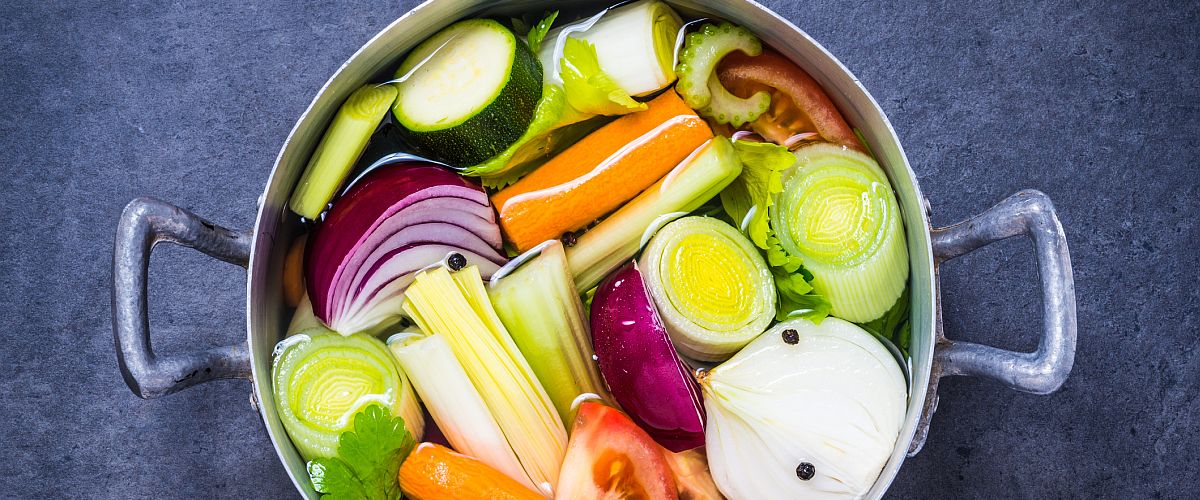Every year, we throw away billions of pounds of food. Food waste in the U.S. is estimated to be around 30-40% of our food supply. That’s equivalent to everyone in the U.S. throwing over 650 apples into the trash.
Wasting food not only misuses the natural and human resources used to grow, harvest, process and transport it, but also contributes to climate change. It’s tough on the pocketbook, too. “The more food we buy that doesn’t actually make it to our plates, the more money we’re wasting,” says Aramark Chef Andrew Bergholtz.
The good news is there’s plenty home cooks can do to help cut down on—and even eliminate—food waste entirely. Food scraps can be put to good use for healthy and delicious meals. “The trick is finding ways to be creative,” Chef Andrew says.

Chef Andrew Bergholtz
Aramark chefs use a proven process to help reduce and eliminate food waste. The process starts by making a menu plan, buying the right ingredients and it goes right through to how food is prepared and portioned.
The approach can apply to everyone cooking at home, as well. When you think about food waste from planning a meal to having those onion and carrot scraps on your cutting board, you’re more likely to end up with less waste.
As much as you can, plan your meals for the week with an eye on portion sizes. Count how many people you need to feed for a meal and multiply by four ounces of protein each, for example, so you know how much chicken or fish to buy.
Chef Andrew also likes to cook with so-called “imperfect” or “ugly” produce. “They’re just as good,” he says. Then, he gets creative with the scraps he does end up with in the kitchen.
We’ve identified challenges when it comes to food waste and gathered top tips, techniques, and recipes home cooks can use to give food scraps a new life in healthy and delicious ways while helping to cut back on waste.
Challenge #1: What do I do with fruit that’s too mushy, slightly brown, or tart?
Solution: We’ve all had that banana bunch that gets a little too ripe for our liking. Instead of tossing the fruit, whip up a banana bread or peel and then freeze the bananas to add to smoothies.
You can also freeze mushy strawberries (and strawberry tops) or even overripe pineapple or a sliced-up pineapple core. If those grapes or plums you bought at the market make your mouth pucker, bag and freeze the fruits instead of eating them raw. Combine tart fruit in a smoothie with sweeter fruits like bananas or cherries.
Some people buy bags of frozen spinach or kale to add to their morning smoothie. Instead, consider using the greens you’d normally toss from veggies like carrots or beets. A beet greens and berry smoothie is quite tasty.
Challenge #2: How can I use fruit and veggie parts and peelings?
Solution: First, try eating skins of produce! Potato, cucumber, kiwi, eggplant, tomato, carrot, apple, and even mango skins are packed with nutrients. Creative ways in which to use peelings include salad toppings, stir fries, and even in your scrambled eggs. Just wash them thoroughly before peeling.
If you don’t like the taste or texture of the skin, or if the skin isn’t edible, take care when peeling, Chef Andrew says. You might find you’re removing not just the skin, but also too much of the veggie or fruit. To remove just the right amount of skin or peel, use a high-quality veggie peeler instead of a knife.
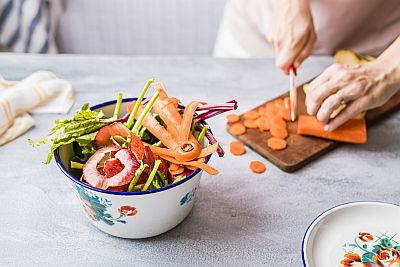 If you have scraps like onion skins, carrot and celery tops, celery leaves, parsley and mushroom stems, use them to make a stock or bone broth. You can throw in bones you’ve saved from a store-bought or homemade whole chicken (remember to freeze those bones instead of throwing them away). Another trick—bag and freeze veggie scraps until you have enough to make a “best of” veggie scrap soup.
If you have scraps like onion skins, carrot and celery tops, celery leaves, parsley and mushroom stems, use them to make a stock or bone broth. You can throw in bones you’ve saved from a store-bought or homemade whole chicken (remember to freeze those bones instead of throwing them away). Another trick—bag and freeze veggie scraps until you have enough to make a “best of” veggie scrap soup.
Potato peels can be washed and dehydrated and then transformed into chips. Season them with extra herbs or your favorite spice. Mushroom tips and scraps go great in a blended burger. Delicious soups can be made from broccoli stalks and also from asparagus ends.
Make a “plant cake” by combining broccoli or cauliflower stems, wilted greens and leftover herb stems with egg, flour, onion, baking powder and seasoning.
Apple and peach peelings are packed with pectin, a natural thickener. Toss the peels into a saucepan with sugar, water, and some berries to make a tasty jam. The natural pectin helps cut down on the required cooking time.
Pear peels can help tenderize meat during the marination process (a tradition used in Korean marinades). Another tasty recipe: make your own “banana peel bacon.”
Instead of throwing out citrus peels, grate skins like oranges and lemons into sauces or desserts, or onto fish and poultry.
Challenge #3: What do I do with excess herbs or leftover stems?
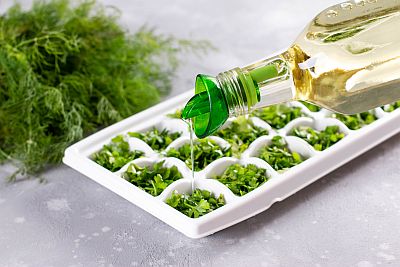 Solution: Infuse olive oil or vinegar with the extra herbs or stems you’d normally discard. Try rosemary, thyme, oregano, tarragon, or basil to add flavor. You can use the same technique for the waste from fresh vanilla pods, says Chef Andrew. After you remove the seeds, place the pods in sugar to make a vanilla sugar.
Solution: Infuse olive oil or vinegar with the extra herbs or stems you’d normally discard. Try rosemary, thyme, oregano, tarragon, or basil to add flavor. You can use the same technique for the waste from fresh vanilla pods, says Chef Andrew. After you remove the seeds, place the pods in sugar to make a vanilla sugar.
Citrus peels are great for infusions, too. Combine orange, grapefruit, or lemon peels with olive oil after first removing as much of the white, bitter skin as you can. The infused oil is a tasty addition to salads.
Another great technique is to freeze extra herbs. Chop them, add them to an ice cube tray, cover with water (or olive oil) and then freeze. After they’re frozen you can pop out the cubes and store them in the freezer inside a plastic bag.
Challenge #4: How can I save saggy produce?
The solution: Sometimes that head of lettuce gets buried in the back of the fridge and it’s not looking so fresh when you finally find it. But you can easily revive wilted greens like lettuces, and even herbs and other limp vegetables, with water.
First, make sure there’s no sign of spoilage like mold or slime. Then, slice the vegetables and submerge them in ice water for 15-20 minutes. This works well because most veggies contain around 90% water that’s lost when you store them in the fridge. Dry the vegetables before you eat them.
Challenge #5: How can I use bread no one wants to eat?
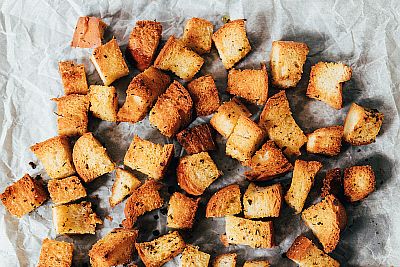 Solution: Bread ends can help restore brown sugar that’s gotten lumpy or hard. Pack one or two bread ends with brown sugar for 24 to 48 hours, Chef Andrew says. The moisture from the bread helps to moisten and soften the sugar.
Solution: Bread ends can help restore brown sugar that’s gotten lumpy or hard. Pack one or two bread ends with brown sugar for 24 to 48 hours, Chef Andrew says. The moisture from the bread helps to moisten and soften the sugar.
Another great way to make use of unwanted pieces of bread is to cut them up for croutons or make your own fresh breadcrumbs.
To make homemade breadcrumbs, toast stale bread and then put it in a food processor. Breadcrumbs make for an excellent coating for chicken or fish, or you could use them as a meatloaf ingredient. Extra health-credit for using whole wheat bread.
For croutons, apply olive oil to the bread, cut it into cubes, season it and then bake for 15 minutes at 350°F.
Challenge #6: What do I with waste I just can’t use or transform?
Solution: For scraps that you simply can’t use in another dish, consider giving them to your plants.
Eggshells are made up of the mineral calcium carbonate, which can enrich the soil. Clean the eggshells, dry them, crumble them and place them in soil before you place your seeds or plants.
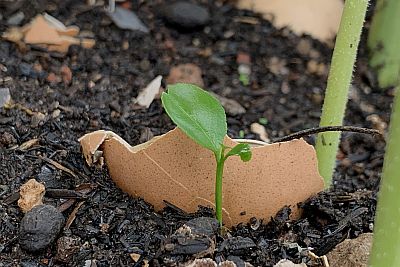 You can also use banana peels in your garden, and scatter coffee grounds around plants, though grounds can inhibit growth in certain plants.
You can also use banana peels in your garden, and scatter coffee grounds around plants, though grounds can inhibit growth in certain plants.
When all else fails, consider composting. Composting involves combining your scraps – from fruit and veggie trimmings, eggshells, and coffee grounds—with flowers and leaves to make a nutrient-rich soil you can then use in your yard.
You can get a composting container for your yard or kitchen. Some cities have composting programs or bins where scraps can be dropped off. The U.S. Environmental Protection Agency offers tips for composting.
Start small by trying out a few of the above tips. We think you’ll find that getting creative in the kitchen with scraps can be a lot of fun, and you’ll feel good about helping to reduce food waste, too.
Note: Since everyone’s health history and nutritional needs are so different, please make sure that you talk with your doctor and a registered dietitian to get advice about the diet and exercise plan that‘s right for you.

